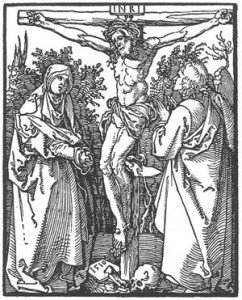 At St Mary’s we have a service of Veneration of the Cross on Good Friday morning at 0930. Its a very simple service – a few prayers and an opportunity again to reflect on the Passion readings. Here we use the Passion from the gospel of the year on Palm Sunday and John’s Passion on Good Friday.
At St Mary’s we have a service of Veneration of the Cross on Good Friday morning at 0930. Its a very simple service – a few prayers and an opportunity again to reflect on the Passion readings. Here we use the Passion from the gospel of the year on Palm Sunday and John’s Passion on Good Friday.
There are two distinctive things about this service. The first is that the church is bare and stripped after the Thursday night’s events. The second is that there is an opportunity to venerate the cross at the end of the service.
The bare, sparse feel of the church on Good Friday is like no other point in the year. The yawning space at the front seems to gape open. There is no sacrament reserved on the High Altar. The font will be closed. Jesus is taken from us and there will be no sacraments now until Easter Day, if such a Day should happen. It always feels unlikely to me on Good Friday that joy will ever come back. There is beauty to be found on Good Friday but it is stark beauty, harsh beauty, hard fought beauty.
The veneration of the cross is simply an opportunity to do something physical. There’s no sermon at this service (which takes just about half an hour) but rather, a chance to come close to a simple cross and say a prayer. Some people will kiss the cross, some will touch it and hold it whilst they pray, some will bow deeply before it. It is a physical act that connects us with the wood of the cross. (There’s a lot of physical touch involved in the triduum – feet, cross, even the cleaning that will come tomorrow – its far from cerebral religion).
The building always seems hushed and quiet at this time. The removal of so many things the night before somehow seems to make it feel achingly quiet. The prayers from the night before seem to linger and meld with the confusion of what it can mean for Christ to have been taken by civil authority and put to death. In some ways there is no sense to be made of today but there is no sense to be made out of most violence.
Sometime today whilst things are quiet, along with one of the servers I’ll wash down the High Altar with vinegar and bitter herbs. It is a gentle and calm act which few people see, symbolising the laying out of Jesus’s body for burial. The smell of the vingegar and the herbs lingers on through the day – a combination of strangeness, cleanliness and bitterness.
Recent Comments